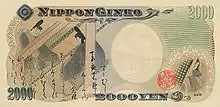2000 yen note
The 2000 yen note (二千円紙幣, Nisen-en shihei) is a denomination of Japanese yen, that was issued on July 19, 2000 to commemorate the 26th G8 Summit and the millennium.[1] The banknote is notable for not being a commemorative banknote under Japanese law, and circulates as a regular issue.[1][2]
| (Japan) | |
|---|---|
| Value | 2000 Yen |
| Width | 154 mm |
| Height | 76 mm |
| Security features | Color-shifting ink, Intaglio printing, Latent imaging, Luminescent ink, Microprinting, Pearl ink, Tactile printing, Watermark, EURion constellation |
| Obverse | |
_front.jpg.webp) | |
| Design | Shureimon |
| Reverse | |
 | |
| Design | The Tale of Genji and Lady Murasaki |
History
The 2000 yen note was first issued on July 19, 2000 under the "D Series".
Design
The design is similar of that of the other Japanese notes in circulation at the time of issue. The obverse has a serial number and depicts Shureimon, a 16th-century gate at Shuri Castle in Naha, in Okinawa Prefecture, Japan. Cherry blossom and chrysanthemum motifs are part of the linear design work in the background. The reverse side depicts a scene from The Tale of Genji, and a portrait of Murasaki Shikibu, the noblewoman to whom this work of classic literature has been attributed. A copy of a portion of script from the original work is included.
Rarity
2000 yen notes are rarely seen in circulation as few vending machines or ATMs accept the denomination, thus they are described as "not convenient" by the public.[3] The bills are also a nuisance to cashiers and business owners as many modern cash registers do not have a slot for the denomination.[4] The Bank of Japan has weighed in by giving factors such as the debut of "Series E" 2004 dated notes which have since entered into circulation. A spokesperson for the bank stated in 2006 that “I think people prefer to hold on to the newer bank notes”, which lowered the demand for the older notes.[3] It was reported in 2019 that The Bank of Japan continues to hold large amounts of 2000 yen notes in reserve, and no new notes of this denomination are currently being printed.[5] The note does enjoy some popularity in Okinawa due to the representation of Shureimon on the note's obverse; some ATMs allow users to specifically withdraw 2000 yen notes in addition to other denominations.[5] Collectors have since taken notice of their rarity in circulation as "2000 yen" notes trade for roughly 1.5x their face value in online sales depending on condition.[6]
See also
- Banknotes of the Japanese yen
- United States two-dollar bill - another banknote denomination of roughly one-tenth the value that is similarly rarely seen in circulation and likewise available upon request from banks.
References
- "2000年(平成12年)4月26日大蔵省告示第117号「平成十二年七月十九日から発行する日本銀行券二千円の様式を定める件」] - 財務省". Ministry of Finance (Japan). Retrieved February 20, 2020.
- "The 2,000 yen banknote-The note originated in Okinawa". www.likejapan.com. September 2, 2019. Retrieved February 20, 2020.
- Akiko Kondo (September 6, 2006). "Unwanted and unloved, 2,000 yen bills find few fans". The Japan Times. Retrieved February 19, 2020.
- Timothy Nerozzi (December 4, 2019). "Who Will Save the 2,000 Yen Bill? The future of Japan's most inconvenient note". Metropolis. Retrieved February 20, 2020.
- Baseel, Carey; Neko, Ahiru. "Why was the 2,000-yen bill left out of Japan's yen redesign, and how does it feel about the snub?". SoraNews24. Retrieved 18 October 2019.
- "2000 yen note". ebay. Retrieved February 19, 2020.
